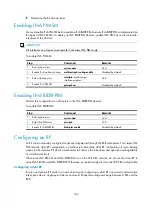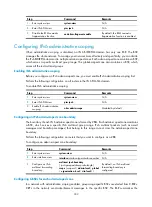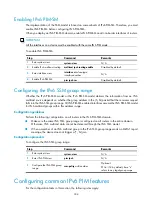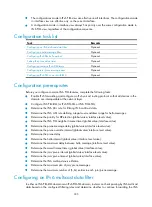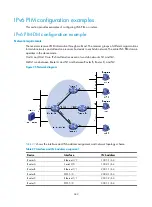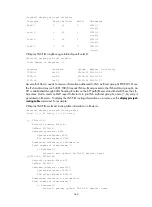
330
To configure an IPv6 BIDIR-PIM domain border:
Step Command
Remarks
1.
Enter system view.
system-view
N/A
2.
Enter interface view.
interface
interface-type
interface-number
N/A
3.
Configure an IPv6 BIDIR-PIM
domain border.
pim ipv6 bsr-boundary
By default, no IPv6 BIDIR-PIM
domain border is configured.
Configuring C-BSR parameters globally
In each IPv6 BIDIR-PIM domain, a unique BSR is elected from C-BSRs. The C-RPs in the IPv6 BIDIR-PIM
domain send advertisement messages to the BSR. The BSR summarizes the advertisement messages to
form an RP-set and advertises it to all routers in the IPv6 BIDIR-PIM domain. All the routers use the same
hash algorithm to get the RP address corresponding to specific multicast groups.
Perform the following configuration on C-BSR routers.
To configure C-BSR parameters globally6:
Step Command
Remarks
1.
Enter system view.
system-view
N/A
2.
Enter IPv6 PIM view.
pim ipv6
N/A
3.
Configure the hash mask
length.
c-bsr hash-length
hash-length
Optional.
126 by default.
4.
Configure the C-BSR priority.
c-bsr priority
priority
Optional.
64 by default.
Configuring C-BSR timers
The BSR election winner multicasts its own IPv6 address and RP-Set information through bootstrap
messages within the entire zone it serves. The BSR floods bootstrap messages throughout the network at
the interval of BS (BSR state) period. Any C-BSR that receives a bootstrap message retains the RP-set for
the length of BS timeout timer, during which no BSR election takes place. If no bootstrap message is
received from the BSR when the BS timeout timer expires, a new BSR election process is triggered among
the C-BSRs.
Perform the following configuration on C-BSR routers.
To configure C-BSR timers:
Step Command
Remarks
1.
Enter system view.
system-view
N/A
2.
Enter IPv6 PIM view.
pim ipv6
N/A











